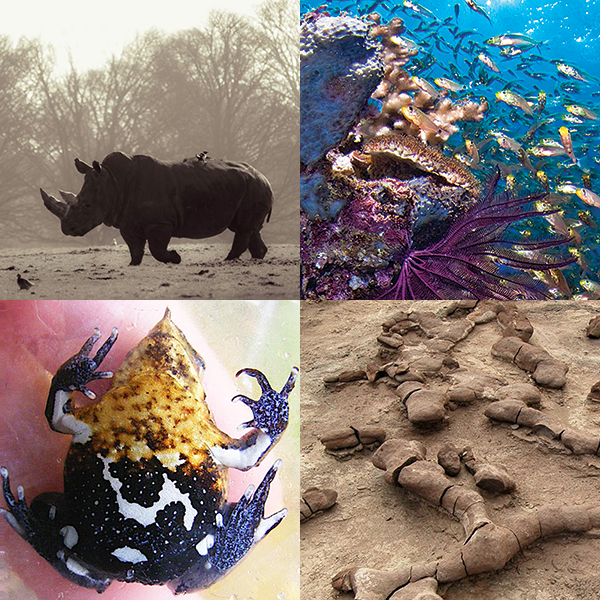The 2015 Ecological Impacts of Climate Change Collection
Post authored by Collection Curator Ben Bond-Lamberty
Many 2014-2015 PLOS publications examined how climate change–past, present, and future–affects the structure and function of ecosystems at diverse scales. The articles highlighted here constitute only a small sample, but nonetheless encompass a wide range of disciplines: paleoecology, biotic and abiotic forest disturbances, soil ecology, conservation biology, mitigation and adaptation, and human health.
Studying past changes in climate and ecosystem disturbances can provide valuable insights into ecosystem function, potential climate feedbacks, and future risks. From fossil leaves before and after one of the most extreme “climate changes” events ever, Blonder et al. concluded that the end-Cretaceous mass extinction preferentially selected for fast-growth strategies in plants, consistent with recovery from an impact winter. Nenzén et al. also used fossil evidence, modeling mammal food webs across 850,000 years, and then inferring how these community structures changed with climate. Using more recent tree-ring and other data, Sherriff et al. examined how wildfire severity has changed over centuries in the western mountains of the U.S. Flower et al. looked at a related question: whether insect outbreaks have increased the severity or probability of such fires. Both studies come to perhaps counter-intuitive conclusions and will stimulate further research.

Of course, climate changes are affecting many present-day ecosystems as well. A wide suite of papers in PLOS journals evaluated mortality, extinction risks, and the efficacy–or not–of conservation networks and protected areas. At-risk species in Canada rarely recover, implying that earlier efforts should be made to protect them, noted Favaro et al. Other studies in PLOS ONE on related themes looked beyond demographic data to examine the fragility of reintroduced Galapagos tortoises; the global extinction risk to freshwater shrimps from invasive species and climate change; the drivers and patterns of ground-dwelling beetle biodiversity across northern Canada; and how warming and acidifying oceans are affecting both benthic invertebrates in the Mediterranean and reef corals in Caribbean and Indo-Pacific.
Another critical current question is how decomposition processes in global soils–which hold far more carbon than is currently in the atmosphere–will respond to climate change. Leifeld et al. used radiocarbon signatures to draw inferences about the root turnover and belowground carbon dynamics of a European alpine grassland. Microbial communities drive decomposition, and Negassa et al. provided experimental evidence that soil pore characteristics affect the structure of these communities. The ecological effects of climate change effects also interact with human structures and health: urbanization changes both local climate and the size and fecundity of orb-weaving spiders, for example, and the sand flies that vector Cutaneous Leishmaniasis, a neglected tropical disease, respond strongly to large-scale El Niño patterns of rainfall and temperature.
How will ecosystems respond to the future climate changes that are almost certainly coming? Hamilton et al. put forth a negative assessment for Canadian polar bears, given current sea ice projections, while Lazarus and McGill note that even tree species with the capacity for long-distance speed dispersal will probably be unable to keep pace with the spatial velocity of future temperature changes. On a similar note, Harris et al. argued that preserving Tasmanian grassland communities in their current form is a losing battle. In less-developed countries such as Ecuador, habitat destruction and land-use pressures are probably larger problems for Mountain Tapirs in the short term, conclude Ortega-Andrade et al., but global warming carries significant longer-term risks for this critically endangered species. These assessments are all based on climate model projections with considerable uncertainty, of course, but emphasize and quantify the potential risks to many current species and ecosystems.
As I wrote a year ago, the broad range of these papers emphasize both the multi-faceted impacts of climate change on natural and human systems, as well as the breadth and depth of research on these subjects being published in PLOS journals.
 Dr. Bond-Lamberty is a Research Scientist at the Joint Global Change Research Institute, a partnership of the Pacific Northwest National Laboratory (PNNL) and the University of Maryland, College Park. His research focuses on carbon cycling in terrestrial ecosystems, particularly boreal and other northern forests, and their response to natural and human-initiated disturbances. He has extensive experience modeling biogeochemical cycling in these systems, as well as in manipulative field and lab experiments. He also acts as a Section Editor for PLOS ONE.
Dr. Bond-Lamberty is a Research Scientist at the Joint Global Change Research Institute, a partnership of the Pacific Northwest National Laboratory (PNNL) and the University of Maryland, College Park. His research focuses on carbon cycling in terrestrial ecosystems, particularly boreal and other northern forests, and their response to natural and human-initiated disturbances. He has extensive experience modeling biogeochemical cycling in these systems, as well as in manipulative field and lab experiments. He also acts as a Section Editor for PLOS ONE.